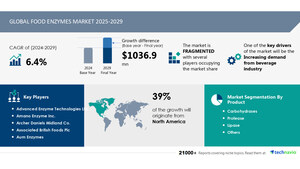NEW YORK, May 10, 2024 /PRNewswire/ -- The global automotive plastics market size is estimated to grow by USD 13.48 bn from 2023-2027, according to Technavio. The market is estimated to grow at a CAGR of 3.35% during the forecast period.
For more insights on the forecast market size and historic data (2017 - 2021) - Buy Report
Forecast period |
2023-2027 |
Growth momentum & CAGR |
Accelerate at a CAGR of 3.35% |
Market growth 2023-2027 |
USD 13.48 billion |
Market structure |
Fragmented |
YoY growth 2022-2023 (%) |
2.99 |
Regional analysis |
APAC, North America, Europe, South America, and Middle East and Africa |
Performing market contribution |
APAC at 45% |
Key countries |
US, China, Japan, India, and Germany |
Key companies profiled |
AGC Inc., Avery Dennison Corp., BASF SE, Berghof GmbH, Borealis AG, BOS GmbH and Co. KG, Cascade Engineering, CIE Automotive SA, Compagnie de Saint Gobain, Covestro AG, Eastman Chemical Co., Evonik Industries AG, Nifco Inc., Nippon Steel Corp., Nolato AB, Novares Group SA, Polystar Technologies LLC., W. L. Gore and Associates Inc., Weber GmbH and Co. KG, and Yachiyo Industry Co. Ltd. |
Market Driver
The automotive industry's shift towards lightweight vehicles is driven by the need to enhance fuel efficiency, decrease greenhouse gas emissions, and meet safety regulations. Advanced plastics and composites, such as Acrylonitrile Butadiene Styrene (ABS), Polypropylene (PP), Polyurethane (PU), Polyamide (PA), Polyvinyl chloride (PVC), Polycarbonate (PC), and Polyethylene (PE), are essential for mass and emission reduction in vehicle parts. OEMs, including Daimler and XEV, are incorporating these materials to meet consumer demand for fuel-efficient and eco-friendly vehicles. The fastest-growing automotive plastics market segments are under-the-hood systems, powertrain systems, and power systems. New vehicle sales, particularly passenger cars, are expected to boost market growth, with OICA reporting significant increases in passenger car sales. Despite safety concerns, lightweight materials are crucial for carbon emissions reduction and fuel economy improvement.
Market Challenges
- The automotive plastics market is driven by the increasing use of advanced features, connectivity, and safety systems in modern vehicles. Plastic components, including those made from polypropylene and polyvinyl chloride, play a crucial role in interior and exterior design, comfort, impact resistance, and dimensional stability. However, the complex design and engineering of molds and tooling for these components can be time-consuming and costly. Overcoming these challenges requires advanced engineering capabilities and collaboration between automakers and plastic suppliers. Electric vehicles and the shift towards gas alternatives also impact the market, influencing production units, inventory systems, and sales and purchase decisions. Additionally, trends such as automotive 3D printing and the re-engineering of plastics for improved durability and aesthetic appeal are shaping the future of the industry.
Research report provides comprehensive data on impact of trend, driver and challenges - Request a sample report!
Segment Overview
This automotive plastics market report extensively covers market segmentation by
- Material
- 1.1 Polypropylene
- 1.2 Polyurethane
- 1.3 Polyvinyl chloride
- 1.4 Polyamide and others
- Vehicle Type
- 2.1 Passenger vehicle
- 2.2 Commercial vehicle
- 2.3 Electric vehicle
- Geography
- 3.1 APAC
- 3.2 North America
- 3.3 Europe
- 3.4 South America
- 3.5 Middle East and Africa
1.1 Polypropylene- The automotive plastics market is experiencing significant growth, particularly in the context of EVs and gas alternatives. With infrastructure development for electric vehicles (EVs) and the re-engineering of plastics for improved sustainability, polymer technology is at the forefront of innovation. Polypropylene (PP), a lightweight and cost-effective thermoplastic polymer, is extensively used in both interior and exterior components. Its properties, including impact resistance, dimensional stability, and durability, align with the demands of modern vehicles. Comfort features, such as soft-touch interiors, are achieved through the use of PP resin, while PP-based materials contribute to weight reduction and improved fuel efficiency. In the realm of electric cars, the focus on reducing reliance on petrochemical reserves and adhering to safety standards, such as BS-VI norms, necessitates the use of advanced polymers. Plastic separation and recycling solutions, like IrgaCycle, play a crucial role in the circular economy, ensuring the efficient use of resources and reducing environmental impact. Automakers are integrating these advancements into their production units, leading to increased sales and employment opportunities. The economic and health impacts of these trends are substantial, with the average car becoming more fuel-efficient and environmentally friendly. Processing abilities and molding properties have advanced, enabling the integration of design elements and safety features. The latest trends in the automotive industry include the adoption of 3D printing for prototyping and customization, further expanding the possibilities of polymers in the sector. Vehicle manufacturers are continually pushing the boundaries of innovation, ensuring that plastics remain a vital component of the automotive landscape.
For more information on market segmentation with geographical analysis including forecast (2023-2027) and historic data (2017-2021) - Download a Sample Report
Research Analysis
The Automotive Plastics Market is experiencing significant growth due to the increasing demand for mass and emission reduction in the transportation sector. Vehicle manufacturers are focusing on using lightweight materials, such as polypropylene resin and polyvinyl chloride (PVC), in the production of passenger car parts. This shift towards plastics is driven by the need to meet environmental standards and reduce carbon emissions. New vehicle sales continue to be a key driver for the automotive plastics market. The integration of IrgaCycle solutions in polymers is enabling the production of high-quality interior aesthetics through injection molding. The processing abilities and molding properties of these materials are essential for meeting safety standards and enhancing fuel efficiency. Moreover, the rising fuel prices and the shift towards electric cars are also impacting the automotive plastics market. The petrochemical reserves used in the production of plastics are a significant factor in the overall cost structure of the industry. Polymer technology continues to evolve, offering new opportunities for innovation and cost savings. In conclusion, the automotive plastics market is a dynamic and evolving industry, driven by the need for mass and emission reduction, fuel efficiency, and the integration of advanced materials and technologies.
Market Research Overview
The Automotive Plastics Market is a significant sector in the global plastics industry, with a growing demand for lightweight and durable materials in vehicle production. Vehicles made with plastic components offer several advantages, including reduced weight, improved fuel efficiency, and enhanced safety features. The market for automotive plastics is driven by factors such as increasing consumer preferences for fuel-efficient vehicles, stringent emission norms, and the growing trend towards electric and hybrid vehicles. Key players in this market include manufacturers of engineering plastics, thermoplastics, and composites. The market is segmented based on the type of plastic, application, and region. The Asia Pacific region is expected to dominate the market due to the presence of major automotive manufacturers and the growing demand for vehicles in the region. The European market is also a significant contributor, with a focus on the development of advanced materials and technologies. The future of the automotive plastics market looks promising, with the increasing adoption of electric and autonomous vehicles and the continuous innovation in plastic materials and manufacturing processes.
Table of Contents:
1 Executive Summary
2 Market Landscape
3 Market Sizing
4 Historic Market Size
5 Five Forces Analysis
6 Market Segmentation
- Material
- Polypropylene
- Polyurethane
- Polyvinyl Chloride
- Polyamide And Others
- Vehicle Type
- Passenger Vehicle
- Commercial Vehicle
- Electric Vehicle
- Geography
- APAC
- North America
- Europe
- South America
- Middle East And Africa
7 Customer Landscape
8 Geographic Landscape
9 Drivers, Challenges, and Trends
10 Company Landscape
11 Company Analysis
12 Appendix
About Technavio
Technavio is a leading global technology research and advisory company. Their research and analysis focuses on emerging market trends and provides actionable insights to help businesses identify market opportunities and develop effective strategies to optimize their market positions.
With over 500 specialized analysts, Technavio's report library consists of more than 17,000 reports and counting, covering 800 technologies, spanning across 50 countries. Their client base consists of enterprises of all sizes, including more than 100 Fortune 500 companies. This growing client base relies on Technavio's comprehensive coverage, extensive research, and actionable market insights to identify opportunities in existing and potential markets and assess their competitive positions within changing market scenarios.
Contacts
Technavio Research
Jesse Maida
Media & Marketing Executive
US: +1 844 364 1100
UK: +44 203 893 3200
Email: [email protected]
Website: www.technavio.com/
SOURCE Technavio

WANT YOUR COMPANY'S NEWS FEATURED ON PRNEWSWIRE.COM?
Newsrooms &
Influencers
Digital Media
Outlets
Journalists
Opted In





Share this article